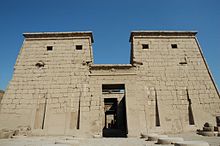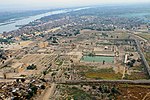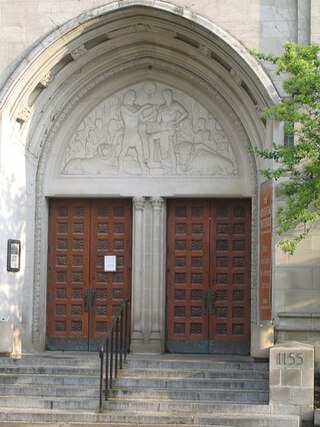
The Institute for the Study of Ancient Cultures, West Asia & North Africa, established in 1919, is the University of Chicago's interdisciplinary research center for ancient Near Eastern studies and archaeology museum. It was founded for the university by Egyptology and ancient history professor James Henry Breasted with funds donated by John D. Rockefeller Jr. It conducts research on ancient civilizations throughout the Near East, including at its facility, Chicago House, in Luxor, Egypt. The institute also publicly exhibits an extensive collection of artifacts related to ancient civilizations and archaeological discoveries at its on-campus building in Hyde Park, Chicago. According to anthropologist William Parkinson of the Field Museum, the ISAC's highly focused "near Eastern, or southwest Asian and Egyptian" collection is one of the finest in the world.

The Luxor Temple is a large Ancient Egyptian temple complex located on the east bank of the Nile River in the city today known as Luxor and was constructed approximately 1400 BCE. In the Egyptian language it was known as ipet resyt, "the southern sanctuary". It was one of the two primary temples on the east bank, the other being Karnak. Unlike the other temples in Thebes, Luxor temple is not dedicated to a cult god or a deified version of the pharaoh in death. Instead, Luxor temple is dedicated to the rejuvenation of kingship; it may have been where many of the pharaohs of Egypt were crowned in reality or conceptually.
Peter FitzGerald Dorman is an epigrapher, philologist, and Egyptologist. Recently a professor of history and archaeology at the American University of Beirut (AUB), he served as the 15th President of the university from 2008 to 2015. He spent most of his career as a professor and chair in the department of Near Eastern Languages and Civilizations (NELC) of the University of Chicago, and was director of Chicago House in Luxor, the Epigraphic Survey field project of the Oriental Institute. He is presently a professor emeritus of the University of Chicago.
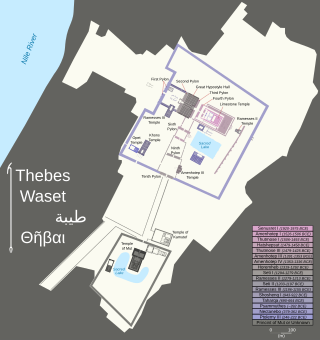
The Precinct of Amun-Re, located near Luxor, Egypt, is one of the four main temple enclosures that make up the immense Karnak Temple Complex. The precinct is by far the largest of these and the only one that is open to the general public. The temple complex is dedicated to the principal god of the Theban Triad, Amun, in the form of Amun-Re.

The Temple of Ramesses III at Medinet Habu was an important New Kingdom period temple structure in the West Bank of Luxor in Egypt. Aside from its size and architectural and artistic importance, the mortuary temple is probably best known as the source of inscribed reliefs depicting the advent and defeat of the Sea Peoples during the reign of Ramesses III.

The Precinct of Mut is an Ancient Egyptian temple compound located in the present city of Luxor, on the east bank of the Nile in South Karnak. The compound is one of the four key ancient temples that creates the Karnak Temple Complex. It is approximately 325 meters south of the precinct of the god Amun. The precinct itself encompasses approximately 90,000 square meters of the entire area. The Mut Precinct contains at least six temples: the Mut Temple, the Contra Temple, and Temples A, B, C, and D. Surrounding the Mut Temple proper, on three sides, is a sacred lake called the Isheru. To the south of the sacred lake is a vast amount of land currently being excavated by Dr. Betsy Bryan and her team from the Johns Hopkins University in Baltimore, Maryland.

Gebel el-Silsila or Gebel Silsileh is 65 km (40 mi) north of Aswan in Upper Egypt, where the cliffs on both sides close to the narrowest point along the length of the entire Nile. The location is between Edfu in the north towards Lower Egypt and Kom Ombo in the south towards Upper Egypt. The name Kheny means "The Place of Rowing". It was used as a major quarry site on both sides of the Nile from at least the 18th Dynasty to Greco-Roman times. Silsila is famous for its New Kingdom stelai and cenotaphs.

The Great Hypostyle Hall is located within the Karnak Temple Complex, in the Precinct of Amon-Re. It is one of the most visited monuments of Ancient Egypt. The structure was built around the 19th Egyptian Dynasty. Its design was initially instituted by Hatshepsut, at the North-west chapel to Amun in the upper terrace of Deir el-Bahri. The name refers to hypostyle architectural pattern.

The Saqqara Bird is a bird-shaped artifact made of sycamore wood, discovered during the 1898 excavation of the tomb of Pa-di-Imen in Saqqara, Egypt. It has been dated to approximately 200 BCE, and is now housed in the Egyptian Museum in Cairo. The Saqqara Bird has a wingspan of 18 cm (7.1 in) and weighs 39.12 g (1.380 oz). Its purpose is not understood because of a lack of period documentation.

The history of the Karnak Temple complex is largely the history of Thebes. The city does not appear to have been of any significance before the Eleventh Dynasty, and any temple building here would have been relatively small and unimportant, with any shrines being dedicated to the early god of Thebes, Montu. The earliest artifact found in the area of the temple is a small, eight-sided column from the Eleventh Dynasty, which mentions Amun-Re. The tomb of Intef II mentions a 'house of Amun', which implies some structure, whether a shrine or a small temple is unknown. The ancient name for Karnak, Ipet-Isut only really refers to the central core structures of the Precinct of Amun-Re, and was in use as early as the 11th Dynasty, again implying the presence of some form of temple before the Middle Kingdom expansion.

The Temple of Ptah is a shrine located within the large Precinct of Amun-Re at Karnak, in Luxor, Egypt. It lies to the north of the main Amun temple, just within the boundary wall. The building was erected by the Pharaoh Thutmose III on the site of an earlier Middle Kingdom temple. The edifice was later enlarged by the Ptolemaic Kingdom.
Richard Anthony Parker was a prominent Egyptologist and professor of Egyptology. Originally from Chicago, he attended Mt. Carmel High School with acclaimed author James T. Farrell. He received an A.B. from Dartmouth College in 1930, and a Ph.D. in Egyptology from the University of Chicago in 1938. He then went to Luxor, Egypt to work as an epigrapher with the University of Chicago's Epigraphic and Architectural Survey, studying the mortuary temple of Ramses III. When World War II necessitated a temporary halt to the project, Parker came back to Chicago to teach Egyptology at the university. In 1946, he returned to Egypt to continue his work on the epigraphic survey, and soon rose to the position of field director.

Tomb TT192, located in the necropolis of El-Assasif in Thebes, Egypt, is the tomb of Kheruef, also called Senaa, who was Steward to the Great Royal Wife Tiye, during the reign of Amenhotep III. It is located in El-Assasif, part of the Theban Necropolis.
The American Research Center in Egypt (ARCE) is an American non-profit dedicated to supporting research in all periods of Egyptian history. It is a member of the Council of American Overseas Research Centers (CAORC).
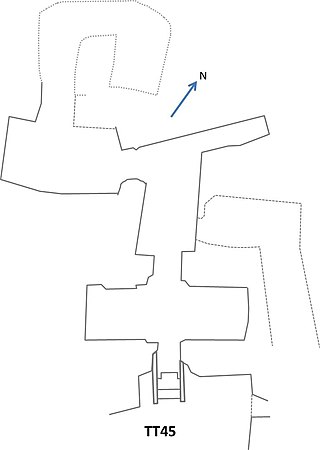
The Theban Tomb TT45 is located in Sheikh Abd el-Qurna, part of the Theban Necropolis, on the west bank of the Nile, opposite modern Luxor. It was originally the burial place of the ancient Egyptian named Djehuty (Thoth), who was a scribe of the offering-table of Mery, high-priest of Amun, head of all the weavers of Amun, and steward of Mery, high priest of Amun. Djehuty lived during the reign of Amenhotep II. He was the son of a lady also named Djehuty.

The Bentresh Stela or Bakhtan Stela is an ancient Egyptian sandstone stela with a hieroglyphic text telling the story of Bentresh, daughter of the prince of Bakhtan, who fell ill and was healed by the Egyptian god Khonsu.

Martha Rhoads Bell was an American archaeologist. Her specialty was Mycenaean imported pottery and imitations found in Egypt and Nubia, as well as Egyptian-Mycenaean interconnections in the New Kingdom and their implications for chronology.

William Joseph Murnane was an American Egyptologist and author of a number of books and monographs on Ancient Egypt. He was director of the Great Hypostyle Hall Project at Luxor Karnak Temple, was a research associate and held a Dunavant Professorship in the History Department of the Institute of Egyptian Art & Archaeology at the University of Memphis. Several of his scholarly monographs are used as standard references by historians and philologists whilst more popular works, which drew on his considerable knowledge of Ancient Egyptian monuments, are used by tourists.

Caroline Ransom Williams was an Egyptologist and classical archaeologist. She was the first American woman to be professionally trained as an Egyptologist. She worked extensively with the Metropolitan Museum of Art (MMA) in New York and other major institutions with Egyptian collections, and published Studies in ancient furniture (1905), The Tomb of Perneb (1916), and The Decoration of the Tomb of Perneb: The Technique and the Color Conventions (1932), among others. During the Epigraphic Survey of the University of Chicago Oriental Institute's first season in Luxor, she helped to develop the "Chicago House method" for copying ancient Egyptian reliefs.
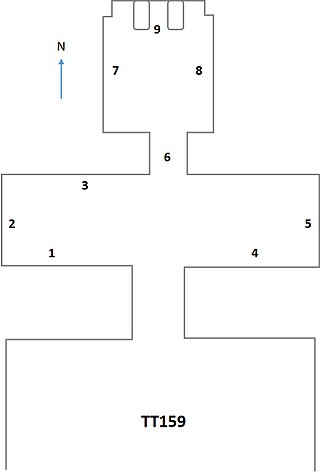
The Theban Tomb TT159 is located in Dra' Abu el-Naga', part of the Theban Necropolis, on the west bank of the Nile, opposite to Luxor.
